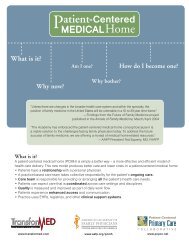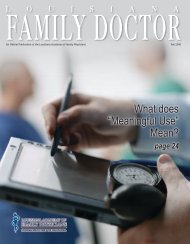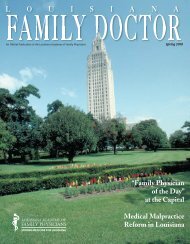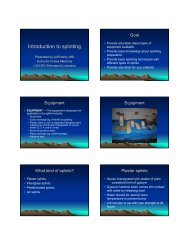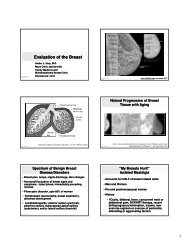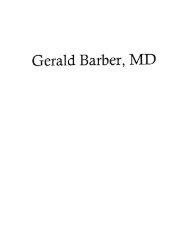New Drug Update 2009-2010 - LAFP
New Drug Update 2009-2010 - LAFP
New Drug Update 2009-2010 - LAFP
You also want an ePaper? Increase the reach of your titles
YUMPU automatically turns print PDFs into web optimized ePapers that Google loves.
Observed cases 2.12 (95% CI, 1.33 to 3.38) c 2.32 (95% CI, 1.44 to 3.73) d<br />
Fibromyalgia pain treatment<br />
BOCF 1.5 (95% CI, 1.05 to 2.13) b 1.68 (95% CI, 1.18 to 2.38) c<br />
LOCF 1.56 (95% CI, 1.11 to 2.19) c 1.9 (95% CI, 1.36 to 2.65) d<br />
Observed cases 1.86 (95% CI, 1.27 to 2.73) d 2.49 (95% CI, 1.69 to 3.66) d<br />
a CI = confidence interval; b P < 0.05 vs placebo.; c P ≤ 0.01 vs placebo.; d P ≤ 0.001 vs placebo.<br />
Milnacipran was also assessed in a randomized, double-blind, placebo-controlled study enrolling 888<br />
patients with fibromyalgia. The majority of patients were women (95.6%) and white (93.6%), with a mean<br />
age of about 49 years and a mean duration of fibromyalgia of 5.6 years. Patients received placebo (223<br />
patients), milnacipran 100 mg/day (224 patients), or milnacipran 200 mg/day (441 patients) for 27 weeks.<br />
Patients were required to discontinue all centrally acting fibromyalgia therapies, including<br />
antidepressants, sedative-hypnotics, muscle relaxants, and centrally acting analgesics, as well as<br />
transcutaneous electrical nerve stimulation, biofeedback, tender and trigger point injections, acupuncture,<br />
and anesthetic or narcotic patches. All analgesics were prohibited except acetaminophen, aspirin, stable<br />
doses of NSAIDs, and limited doses of rescue hydrocodone. The primary efficacy end point for the<br />
“treatment of fibromyalgia” was a composite defining responders as patients with at least 30% pain<br />
improvement as assessed by the change from baseline in 24-hour morning recall pain collected from<br />
daily e-diary scores, a rating of “very much improved” or “much improved” on the PGIC, and an at least 6-<br />
point improvement from baseline in physical function (SF-36 Physical Component Summary score). The<br />
primary end point measure for “treatment of pain of fibromyalgia” was a composite defining responders as<br />
patients achieving at least 30% improvement in pain in 24-hour morning recall pain and rating themselves<br />
as “very much improved” or “much improved” on the PGIC scale. Missing data were analyzed using<br />
BOCF for the week-15 evaluation. At the week-27 assessment, BOCF was utilized for patients<br />
prematurely discontinuing the study before week 15, and LOCF was used for patients who completed<br />
week 15 but discontinued prior to week 27. Results for patients completing the study and those with<br />
partial data are summarized in Table 4. Overall, in the modified intent-to-treat analysis, composite<br />
responses were not consistently achieved in more milnacipran-treated patients at 3 months or at 6<br />
months. Improvements were observed with milnacipran on the secondary end points of morning recall<br />
pain scores (P = 0.01), real-time pain scores (P = 0.01), weekly recall pain scores (P = 0.018), PGIC (P <<br />
0.001), multidimensional Fatigue Inventory total score (P = 0.016), the Multiple Ability Selfreport<br />
Questionnaire (MASQ) cognition total score (P = 0.025), and multiple domains of the SF-36.<br />
Improvements were not observed in sleep quality or quantity. Among subjects completing the study, the<br />
composite pain response rate was 27.2% for placebo, 45.2% for milnacipran 100 mg/day, and 45.4% for<br />
milnacipran 200 mg/day; however, dropout rates were 35% in the placebo group, 43% in the 100 mg/day<br />
group, and 46% in the 200 mg/day group (J Rheumatol. <strong>2009</strong>;36(2):398-409).<br />
A randomized, blinded extension to this study enrolled 449 patients who were either maintained on<br />
milnacipran 200 mg/day (209 patients) or re-randomized from placebo or milnacipran 100 mg/day to<br />
milnacipran 100 mg/day (48 patients) or 200 mg/day (192 patients) for an additional 6 months of therapy.<br />
Among patients re-randomized from placebo to milnacipran 200 mg/day, pain scores improved 47%<br />
(mean pain score declined from 53.9 to 39.4). Among those continuing milnacipran, VAS pain scores<br />
remained consistent (42 mm at week 27, 39.2 mm at week 38, 39.5 mm at week 44, and 38.6 mm at<br />
week 52) and improvements on the PGIC and pain, stiffness, tiredness, and depressed mood times of the<br />
Fibromyalgia Impact Questionnaire (FIQ) were maintained over 12 months. Sixty-seven percent of<br />
patients completed the extension study (Arthritis Rheum. 2008;58(9)(suppl):S383).<br />
Table 4. Composite Response Rates With Milnacipran in Patients With Fibromyalgia<br />
Parameter Placebo (n =<br />
223)<br />
Milnacipran 100 mg/day (n =<br />
224)<br />
Milnacipran 200 mg/day (n =<br />
441)<br />
Fibromyalgia treatment (>/=30% pain decrease, a reduction in PGIC and SF 36)<br />
Week 15<br />
BOCF 12.1% 19.6% (P = 0.028) 19.3% (P = 0.017)<br />
61




